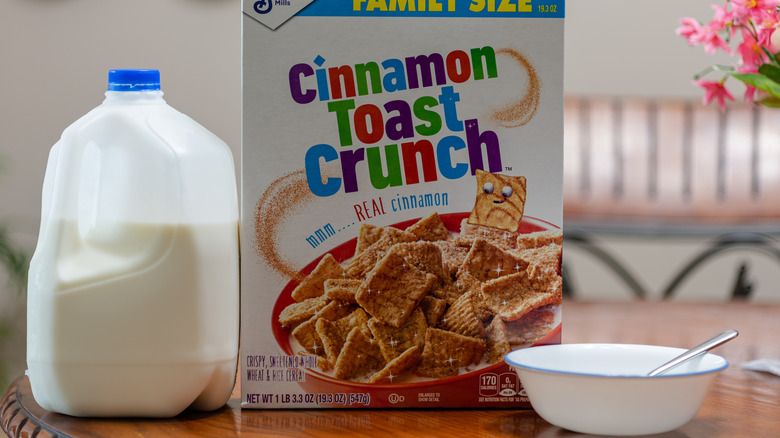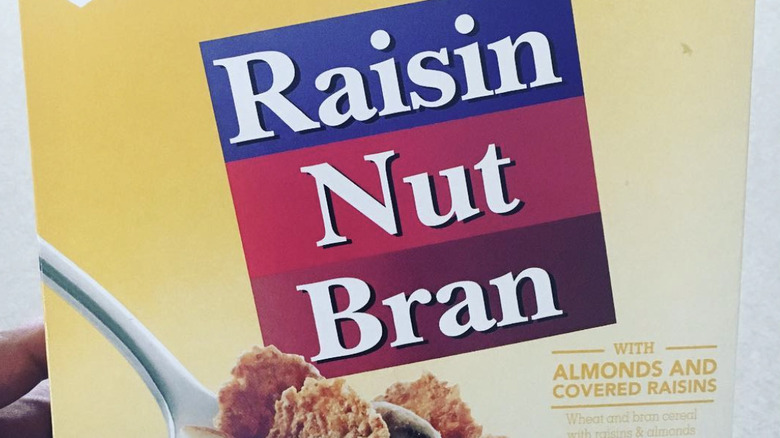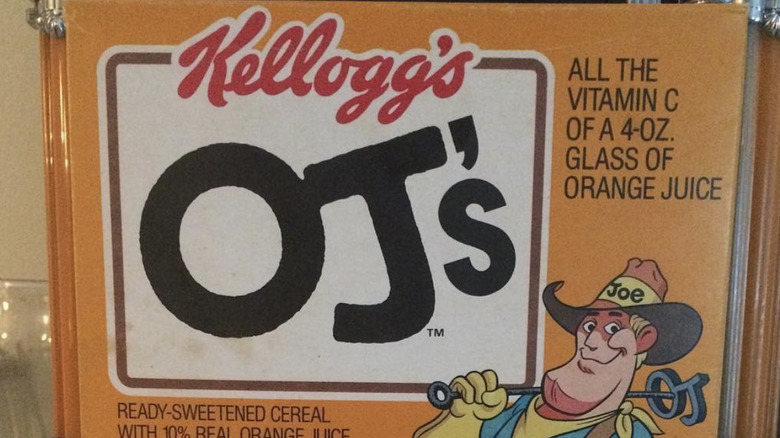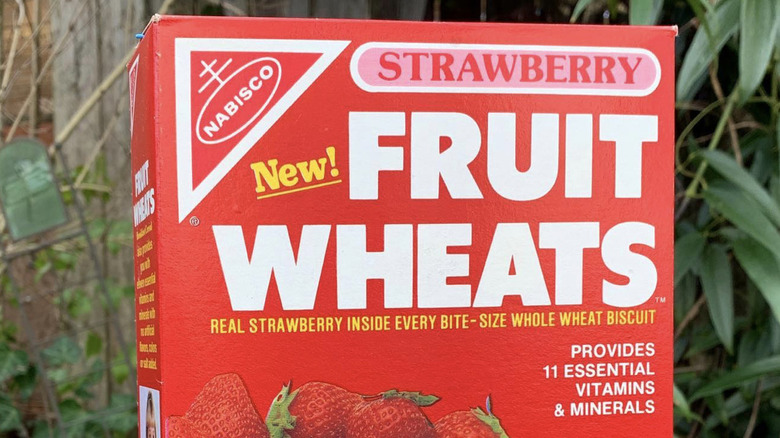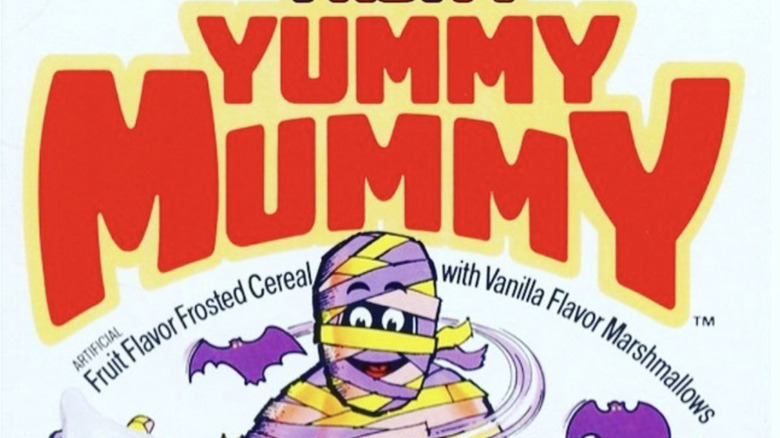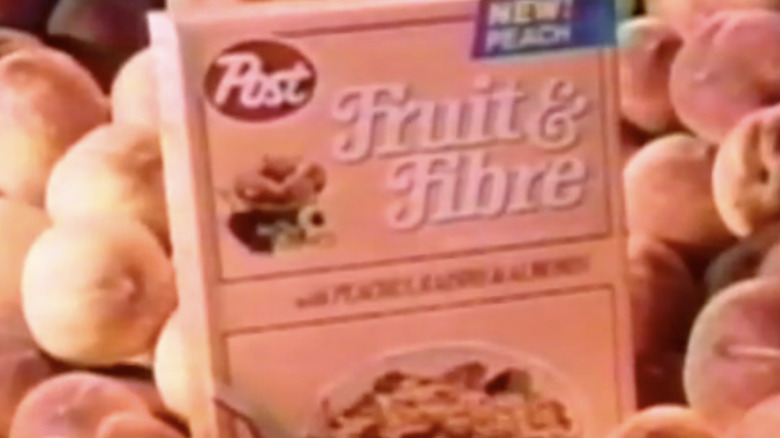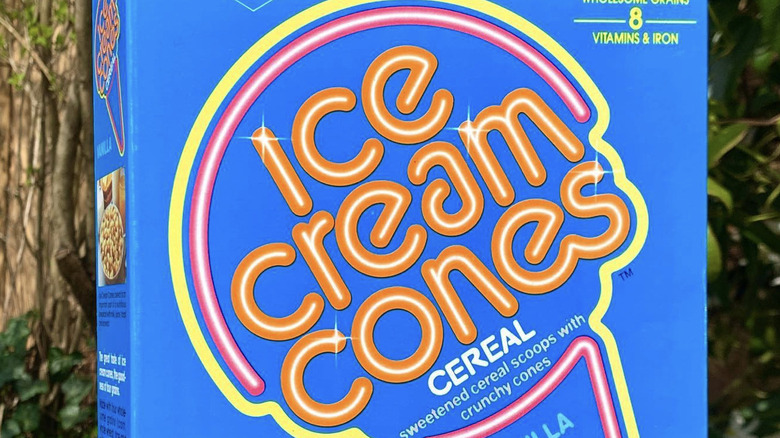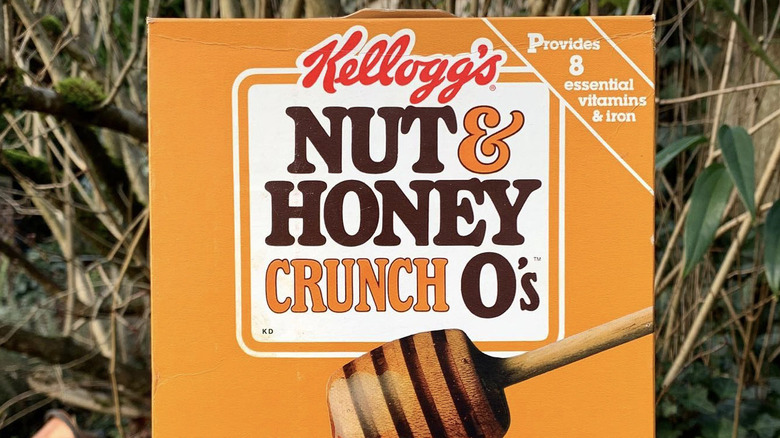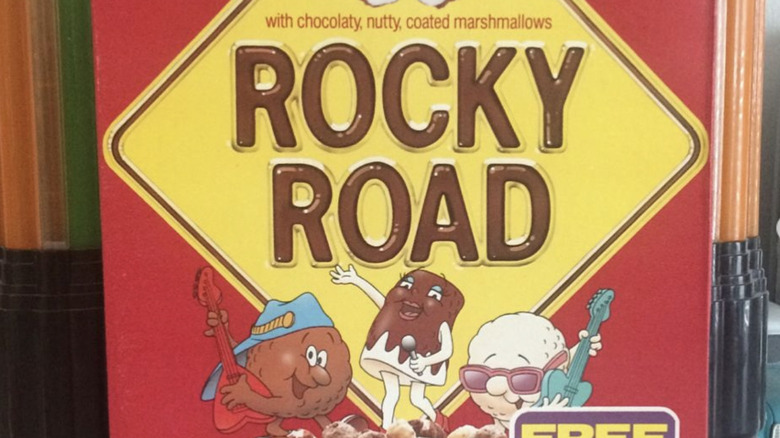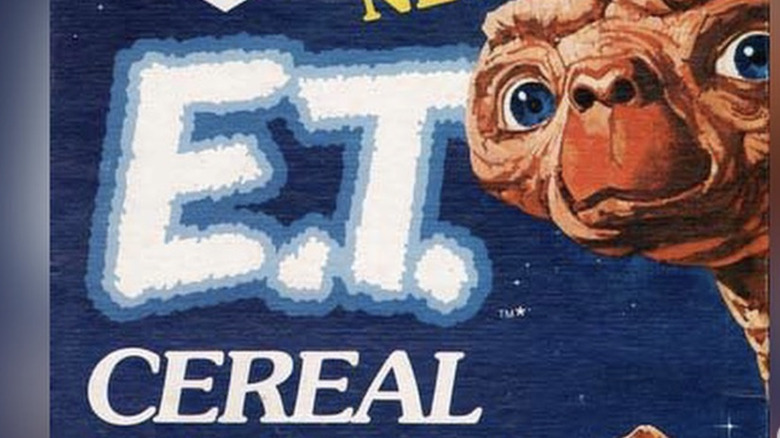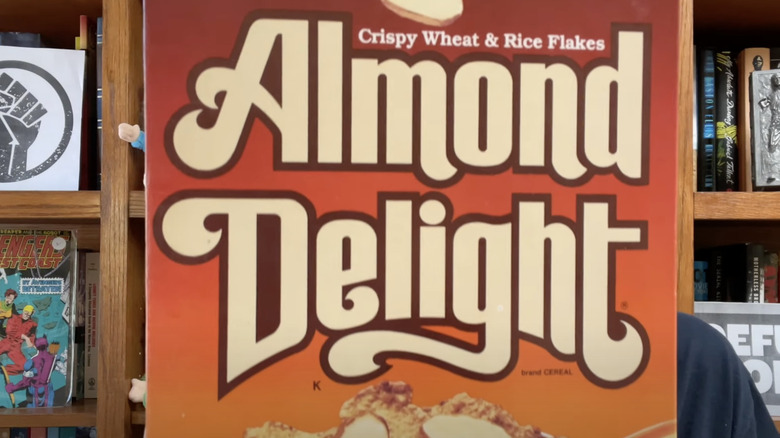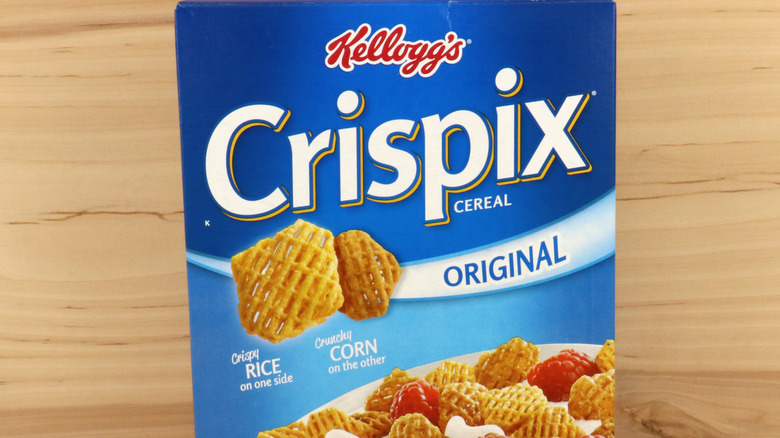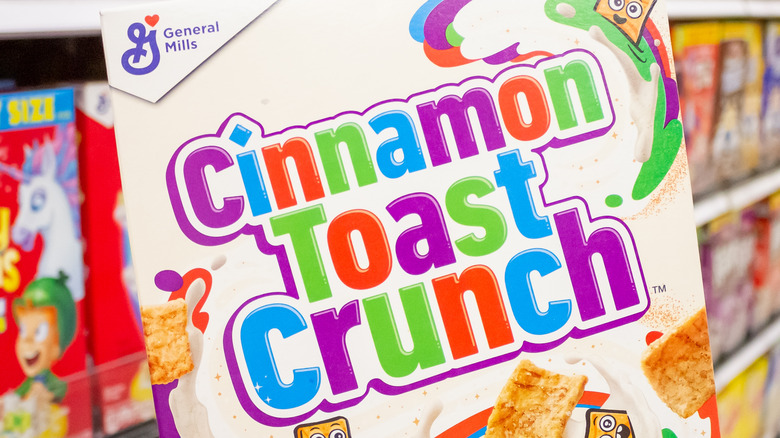The Top 12 '80s Breakfast Cereals, Ranked
The 1980s were a golden age for breakfast cereal, with manufacturers jazzing up the marketing and bringing daring new ingredients to the fore. The two big movements in this sector were the opposite of one another — the '80s saw a glut of heavily-sweetened, sugary cereals, despite most brands trying to drop or avoid the use of the word "sugar" in their names (via MeTV) to avoid criticism. It was also a time when consumers were extremely interested in diet foods (according to Bon Appétit); the decade saw a boom in processed, packaged foods marketing themselves as "healthy." Regardless, the '80s were a rich era for the consumer economy and advertising alike, but with the proliferation of children's television and the popularity of Saturday morning cartoons, cereal became less of a food and more of a pop culture medium, with TV shows, toys, and movies generating tie-in breakfast foods.
Many wonderful and memorable cereals were launched in the 1980s. While several were definitely products of their time, a few hung around to become all-time favorites. So get yourself ready for a balanced breakfast and take a look back to the time of leg warmers, aerobics, and the Smurfs with this list of exemplary cereals from the '80s, ranked from least to most awesome.
12. Raisin Nut Bran
Cereals consisting of little more than toasted wheat-based flakes, heavy on the bran, and with the addition of some wholesome sweetness in the form of a smattering of raisins, had been around since the early 20th century. This old-fashioned cereal category was pioneered by the company Skinner, which tried to copyright the term "Raisin Bran," but ultimately failed in its efforts, leading to many cereals of the same name from other companies.
The '80s were all about glitz, glamor, and superficiality, and those concepts even rocked old-fashioned flakes-and-raisins cereals with the 1987 introduction of General Mills' Raisin Nut Bran. Like Kellogg's Raisin Bran, it started with a foundation of barely sweet but toasty wheat bran flakes, to which were added raisins covered in a crunchy, pulverized nut mix. And then, to fully justify the addition of "Nut" in the name, Raisin Nut Bran got an injection of slivered almonds. The cereal can still be found in stores well into the 21st century. However, it's still too boring and healthy to rank very high on this list of '80s cereals.
11. OJ's
Fruity packaged cereals have historically and overwhelmingly favored strawberries, blueberries, raisins, and apples. The cereal industry has had a much harder time getting the general public to be open-minded about citrus fruit-flavored cereal and get enough consumers on board to create demand for a product that can endure in the crowded marketplace for more than a year or two.
One attempt at citrus cereal was OJ's, a 1985 introduction by Kellogg's. Logically, the cereal pieces were "O"-shaped like so many others that came before and after OJ's. Meanwhile, Kellogg's was no less than emphatic about the orange-ness of OJ's — the box was orange, included the image of a cowboy mascot named Joe the OJ's Orange Rancher, and claimed to be fortified with as much Vitamin C as half a glass of orange juice, thus saving calories and time at breakfast.
The heavily sweetened, bright, tangy, and boldly citrusy taste of O.J.'s offered something wildly different than anything else on the cereal aisle at the time, and with the addition of milk, the product tasted kind of like an Orange Julius, but crunchy. Perhaps it's because mixing orange juice and milk just sounds gross enough to dissuade mass consumption, but Kellogg's discontinued OJ's after a year.
10. Fruit Wheats
In playing to the social climbing vibe that would permeate society in the 1980s, the ear-worm of a jingle in TV commercials for Nabisco's Fruit Wheats proclaimed the product to be "The 'In' Cereal." That slogan had two meanings, in that everything that made Fruit Wheats special was hiding inside the cereal pieces. And this little cereal faced a huge task: To make Shredded Wheat taste good and to not feel like a chore.
Similar to how Frosted Mini-Wheats took the imposing, gigantic biscuits of flavorless whole grains and made them palatable by making them bite-size and sugar-coated, Fruit Wheats shrunk down Shredded Wheat into tiny little nuggets and then filled them with a sweet, jam-like fruit paste — the customer could choose from strawberry, apple, and raisin. Fruit Wheats seemed healthy, because of the wheat element, but also tasty and fun, because of the sticky fruity stuff inside every bite. It kind of felt like the unique and pleasant experience of eating a big bowl of miniature Pop-Tarts. However, the presence of Shredded Wheat in this cereal knocks it down the list a bit.
9. Yummy Mummy
The world just didn't know it was missing cartoonish horror and undead haunted monsters from the breakfast table. When General Mills launched its line of Monster cereals in the early 1970s, they were a smash hit, turning the mascots named after their respective cereals into pop culture icons, including vampiric Count Chocula, monstrous Franken Berry, and ghostly Boo Berry.
General Mills attempted a soft reboot of the series in 1988, introducing another monster and their cereal to the scene: Yummy Mummy, also known as Fruity Yummy Mummy, advertised by a zombie-like animated mummy, wrapped in pink and yellow bandages that resembled some of the colors used in the cereal. The grain-based, frosted, vanilla-flavored, skull-shaped cereal bits were red and orange, while the yellow pieces were those sort-of-crunchy, sort-of-chewy marshmallow pieces found in Count Chocula or Lucky Charms.
Yummy Mummy tasted like tropical punch, a welcome addition to the breakfast world, but mixed with vanilla flavors and offering several varying textures that interplayed with each other nicely. Alas, this cereal represented by an undead creature wouldn't live forever, as General Mills discontinued it in the early 1990s.
8. Fruit and Fibre
Fiber was a dietary phenomenon in the 1980s (via The Oklahoman), the nutrient that doctors and scientists said would lower cholesterol and the risk of heart disease — two health boogeymen then as they are now. While the solution to improved health was simple — eat more fiber — the execution left a lot to be desired. High-fiber cereals didn't excite the masses because they just didn't seem to be very appetizing — Shredded Wheat consisted of an unsweetened, unflavored brick of grain fibers, while All-Bran promised a sedate bowl of brown sticks.
Enter Post with its Fruit and Fibre, whose ads called out its woeful competition with the slogan, "Tastes so good you'll forget the fiber." And that was an entirely possible claim. Fruit and Fibre (with fiber spelled in a European way, as to seem fancy) emphasized the fruit in the recipe, packing boxes of its original formulation with not just raisins but also dates. Then it added some crunch (and a protein boost) with little pieces of walnut, a nut not often found in mainstream breakfast cereals. All that served well in masking the healthy stuff and the reason for the cereal's existence: vitamin-enriched wheat and bran flakes. Fruit and Fibre just tasted like a big bowl of different nuts and fruits — very unlike the anonymous wheat flakes that served as its basis.
7. Ice Cream Cones
General Mills saw Ralston's Cookie Crisp cereal, a hit since its late 1970s introduction, and raised the stakes in the desserts-for-breakfast game. Sure, miniature chocolate chip cookies masquerading as a cereal first thing in the morning was a fun treat and let kids feel like they were getting away with something, but that couldn't possibly compare to the naughty novelty of ice cream for breakfast.
In 1987, General Mills launched Ice Cream Cones, a two-pronged sweetened cereal attack featuring pieces that tasted like ice cream and others that looked and tasted like the cones one would find at a scoop shop. Presented as "scoops," the little round balls looked like whitened Kix pieces but tasted strongly of vanilla and sugar. Those came mixed up with tiny little waffle cones that really did taste like the real thing. Some milk on top softened things out and brought out the dairy origins of those ice cream scoops as well as accentuating the fake-tasting but still preeminent vanilla kick.
6. Nut & Honey Crunch
The sweet, creamy, and specific taste of honey and the savoriness and crunch promised by a vaguely stated blend of "nuts" is a tried and true cereal flavor combo, most famously as the pairing that made sensible Cheerios into the terrific Honey Nut Cheerios. That's a General Mills cereal, however, and by the '80s, Kellogg's wanted a taste of the action and unveiled the flake-oriented Nut & Honey Crunch, the shredded Nut & Honey Crunch Biscuits, and the more directly competitive spinoff, Nut & Honey Crunch O's. At the peak of its popularity in the 1980s, Nut & Honey was perhaps better known for its cheeky ad campaign, emphasizing the wordplay in its name — people would ask their spouse about the new cereal they're eating and they'd say "Nut and Honey," which sounded like "nuttin' honey," thus amusingly offending or confusing the asker.
The cereal itself was nowhere near offensive — they were essentially Corn Flakes boldly reinvented for the 1980s. Each and every flake arrived caked in a potent, honey-flavored glaze that worked to prevent the cereal from going soggy in milk while also providing a sweetness more sophisticated than that of Frosted Flakes, but with that signature buzz of honey. Those flakes went nicely with the extremely tiny bits of nuts affixed to the flakes that featured prominently in every bite.
5. Rocky Road
A quick read through of this list shows that cereal producers in the 1980s were big on adding as much stuff as possible to existing cereal concepts, coating puffs and flakes in sweeteners and nuts, or throwing in as many fruits and almond slivers as they could get away with. General Mills took that ambitious, wide-eyed approach with Rocky Road. Launched in 1986, it was unabashedly unhealthy, absolutely loaded with sugar and treats (in the cereal itself) and novelties (in the marketing) in order to get kids to persuade their parents to buy them a box.
While probably not the most nutritious way to start the day, it's hard to care about healthy eating when a person's got a big bowl of dessert in front of them. Rocky Road was absolutely delicious, built on a foundation of puffed corn balls, which cereal engineers heavily sweetened to differentiate them from their somber, less sugary cousins in Kix. Alongside those whitish yellow cereal balls came little brown balls of the same size — but those weren't cereal at all, but rather miniature marshmallows. Already sweet, those came coated in a chocolate mixture, and after that, they got another upgrade with finely-diced nut topping. Perhaps it was too much of a good thing — Rocky Road disappeared not long after its debut, despite boasting three advertising mascots, a rock band consisting of guitarists Choco and Van and singer Marsha.
4. E.T. Cereal
Pretty much any and every kid-friendly pop cultural property in the 1980s received a marketing tie-in of a cereal adaptation, according to Mental Floss. By and large, the cereals themselves were uninteresting, generic clones of other, more familiar brands formed into appropriate shapes with some marshmallows added and loaded into a brightly-colored box covered in branded imagery.
General Mills' E.T. Cereal hit the market in 1984, nearly two years after "E.T.: The Extra-Terrestrial" began its ascent to the top of the movie blockbusters list (via the Washington Post). And while the lovable titular alien and his light-up finger are all over the box, the cereal inside is both actually tasty and cleverly salutes its inspiration. The pieces are "T"-shaped, made from a puffed, two-grain blend, and were flavored with chocolate and peanut butter, which may have been a nod to E.T. the character's affinity for Reese's Pieces candy. E.T. Cereal was merely a branded predecessor to the excellent Reese's Puffs — per Snack History, that cereal would emerge in the early '90s and taste almost exactly the same: A crunchy version of Reese's Peanut Butter Cups with the perfect combination of sweet chocolate and tangy peanut butter.
3. Almond Delight
Cereal maker Ralston was never as big as cereal giants like General Mills, Post, or Kellogg's, so it turned to innovation to make headway in the marketplace (via The Washington Post). In 1986, for example, it proved that flakes made of more than one cereal grain were possible. Wheaties are made of wheat, Rice Krispies are made from rice, but Almond Delight's crunchy, flat, and toasted flakes were made from both. And while that one innovation would be enough to differentiate a new cereal in the 1980s, Ralston didn't even make a big deal of its mixed-grain approach, because Almond Delight was all about the nuts — something more akin to European muesli with all that plant-based and crunchy protein, but sweeter and more flavor-packed, like a mass-produced American breakfast cereal.
This cereal, which was sweetened with brown sugar, sugar, and coconut, was sugary enough to compete with the kids' stuff of the era, but marketed as a staid and serious product for true grown-ups; Ralston even ran a promotion where they placed actual U.S. currency in boxes, along with replicas of historically interesting money (via Mr. Breakfast). Almond Delight was ultimately all about the nuts — there were almost as many slivered almonds in a box as there were the flakes (which were light and airy because of the rice, and stayed crisp in milk because of the heftier wheat component), ensuring a perfect ratio of grains-to-nuts in almost every bite.
2. Crispix
Cereal companies have often engaged in games of one-up-man-ship, taking the other's product and trying to improve on it in some way in pursuit of customers' dollars, hearts, and stomachs. Case in point: Ralston (which was later bought by General Mills) created one of the most ubiquitous cereal lines of all time with Chex (via The Washington Post). Available in corn, rice, or wheat-based varieties, Chex are uncomplicated, gently sweetened little pockets made from braided grains. But they were only ever made of one grain, and they were always square. What if, the cereal scientists at Kellogg's seemingly theorized, they could create a Chex-like cereal made from two different grains, and in a more excitable shape with more sides?
They succeeded in creating Crispix, Kellogg's next-level response to Chex. One side of each airy, pocket piece is made of criss-crossed corn, which is fused to the opposite side consisting of rice. Oh, and instead of four sides, Crispix has six — it's a three-dimensional, six-sided cereal. And it's all just lightly sweetened enough to make for a wholesome and reliable cereal choice. The whole package makes Crispix the best cereal for grown-ups that emerged in the 1980s. We can see why it has stuck around for nearly 40 years.
1. Cinnamon Toast Crunch
Cinnamon Toast Crunch is a cereal so delicious, so universally liked, and still so popular — it's one of the top five best-selling packaged breakfast cereals of any kind in the United States, according to Kiplinger — that it's almost hard to believe it hasn't been around forever, like Corn Flakes or Wheaties. But somehow, Cinnamon Toast Crunch isn't even 40 years old, hitting store shelves in 1984.
Deceptively thin and more crispy than they are crunchy, as the name would imply, General Mills Cinnamon Toast Crunch pieces hold up well in cold milk. They're made from a combination of whole wheat and rice, fortified with vitamins, and then formed into squares in order to resemble little pieces of bread (via Cinnamon Toast Crunch). To make those faux-bread slices look and taste more like a cinnamon-heavy take on actual French toast, they're striped with brown adornments and coated in a blend of what feels like equal parts cinnamon and sugar. It's an instant taste overload, as Cinnamon Toast Crunch hits with as much spice as it does sweetness.
Cereal can often seem like a quick and cold replacement for a hot breakfast, but in this case, Cinnamon Toast Crunch defeats even actual French toast made with cinnamon and sugar. It's the best breakfast food to come out of the entirety of the 1980s.
